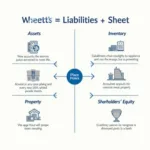TOEIC (Test of English for International Communication) is a widely recognized English proficiency exam. However, many test-takers fall into common traps, making it challenging to achieve a high score. In this article, we’ll delve into Common TOEIC Traps From Scratch and offer strategies to overcome them effectively. Whether you’re a beginner or an experienced TOEIC student, understanding these traps is crucial for success.
1. Misinterpreting Question Types
One of the first traps TOEIC test-takers encounter is misinterpreting the question type. The TOEIC is designed to assess various aspects of language proficiency, and each section has its own unique question format.
How To Avoid:
- Carefully read the instructions for each section. For example, in the Listening section, clarity in instruction comprehension is essential.
- Familiarize yourself with common question types in advance for both Listening and Reading sections.
Expert tip from Nguyễn Thu Hương, TOEIC coach: “Exposing yourself to authentic TOEIC materials is the key. Misinterpreting question types can happen due to unfamiliarity with the format.”
For a comprehensive guide on mastering this challenge, check out common TOEIC traps step by step.
2. Ignoring Context Clues in Listening
Many students lose points by focusing solely on specific words instead of understanding the overall context in the Listening section. The TOEIC is designed to assess your ability to grasp meaning in real-world contexts, so fixating on exact wording might lead to irrelevant or incorrect answers.
How To Avoid:
- Practice listening to full segments (conversations and talks).
- Pay attention to tone, purpose, and speaker attitude.
- Take note of key contextual words and phrases that indicate the overall meaning.
If you struggle with common mistakes, you’ll find useful resources in common TOEIC mistakes in one week.
3. Neglecting Time Management
TOEIC is a timed exam. A common trap for many test-takers is failing to monitor time effectively, especially in the Reading section. Overemphasizing difficult questions may result in not having enough time for easier ones.
How To Avoid:
- Divide your time wisely. For example, the 75 minutes allocated for Reading requires strategic time management, meaning approximately 20–25 minutes per section.
- Practice skimming and scanning techniques to speed up your reading comprehension without sacrificing accuracy.
Expert advice from Lê Minh Đạt, a TOEIC test administrator: “Understanding when to move on is key in TOEIC. Spending too much time on one question can hurt your score by leaving easier questions unanswered.”
4. Vocabulary Traps: Synonyms and Related Words
TOEIC often presents answer choices with synonyms or similarly related words, which is a common trick that confuses test-takers. You may assume two words have identical meanings, but subtle differences often determine the correct answer.
How To Avoid:
- Expand your vocabulary by studying related words and phrases.
- Practice with exercises focusing on understanding nuances between synonyms.
For more tips on avoiding vocabulary-related errors, consult common TOEIC mistakes from scratch.
5. Skipping Detail in Double Passages
The double-passage questions in the Reading section examine your ability to compare and contrast information from two different texts. One very common trap is failing to link details between the two passages, leading to incorrect conclusions.
How To Avoid:
- Be sure to read both passages carefully before jumping to the questions.
- Focus on understanding how the two texts are connected, whether by topic, timeline, or argument.
Sample Pitfall To Watch Out For:
| Section | Common Trap | Tip to Avoid |
|---|---|---|
| Double Passage | Overlooking differences | Take notes on major points in each text |
| Email/ Letter | Misreading sender’s intention | Understand the formal and pragmatic tone |
6. Overthinking Simple Grammar Questions
In the Written Expression part, TOEIC often includes relatively straightforward grammar questions that some test-takers tend to overthink. As a result, they may choose complex, incorrect answers when a simple, grammatically correct option is sufficient.
How To Avoid:
- Trust your initial instinct, especially if you feel confident about basic grammatical rules.
- Practice eliminating implausible choices first, which can help clarify the correct answer.
For more advanced tips on tackling traps like these, try common TOEIC mistakes like a pro.
7. Underestimating Inference Questions
Inference questions, particularly in the Reading section, can trap test-takers into guessing rather than deducing the correct answer. These questions require you to draw conclusions from the given information without explicitly stating the answer.
How To Avoid:
- Understand that an inference-based question isn’t asking for restatement but conclusion.
- Revisit key sentences or paragraphs to clarify what can logically be inferred.
Expert insight from Trần Bảo Anh, an English teacher with over 10 years of experience: “The most common mistake I see with inference questions is that students rush to guess. Instead, take a moment to identify the relationships presented in the text.”
Conclusion
Avoiding common TOEIC traps from scratch is achievable with consistent practice and preparation. Focus on understanding the TOEIC structure, managing your time wisely, and sharpening your comprehension skills. By learning to recognize these traps, you’ll be one step closer to achieving the TOEIC score you aim for.
FAQ: Common Questions About TOEIC Traps
1. What’s the biggest mistake TOEIC test-takers make?
A common mistake is misinterpreting the question format, especially in the Listening part.
2. How much time should I spend on reading double passages?
Allocate about 10–15 minutes. Make sure to read both passages before attempting questions.
3. How do I avoid overthinking grammar questions?
Confidence in basic grammar rules and eliminating improbable answer choices are key strategies.
4. Is vocabulary memorization enough to avoid traps?
Vocabulary alone is not enough. You need to understand context, nuances, and how words fit grammatically in sentences.
5. How can I pace myself better during the exam?
Practice timed TOEIC mock tests regularly to develop a natural sense for time management.
Prepare well, stay aware of these pitfalls, and best of luck with your TOEIC test!




